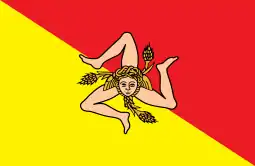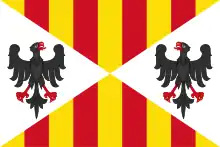 | |
| Trinacria[1] | |
| Use | Civil and state flag |
|---|---|
| Proportion | 13:20 (as shown above), 2:3 or 3:5 |
| Adopted | 4 January 2000 |
| Design | Divided diagonally from the upper hoist-side corner; the upper triangle is red and the lower triangle is yellow; in the center is the Sicilian triskelion featuring the winged head of Medusa with three ears of wheat protruding from it. |
The flag of Sicily (Sicilian: Bannera dâ Sicilia; Italian: Bandiera della Sicilia) shows a triskeles symbol (a figure of three legs arranged in rotational symmetry), and at its center a Gorgoneion (depiction of the head of Medusa) and a pair of wings and three wheat ears. In the original flag, the wheat ears did not exist and the colors were reversed. The original flag was created in 1282 during the rebellion of the Sicilian Vespers.
Description
The flag is characterized by the presence of the triskeles in its middle, the (winged) head of Medusa and three wheat ears, representing the extreme fertility of the land of Sicily. [2] The triskelion symbol is said to represent the three capes (headlands or promontories of the island of Sicily), namely: Pelorus (Peloro, Tip of Faro, Messina: North-East); Pachynus (Passero, Syracuse: South); and Lilybæum (Lilibeo, Cape Boeo, Marsala: West), which form three points of a triangle from the historical three valli of the island.[3][4]
The flag is bisected diagonally into regions colored red, the color of Palermo, and yellow, the color of Corleone. These are the two cities that started the revolution of the Sicilian Vespers. The flag was used during the medieval revolution of the Vespers. [5]
History

The Triskeles-with-Gorgoneion symbol is found in antiquity, depicted on coins minted in Syracuse in the 4th century BC. The emblem was included in the design of the Army Gold Medal awarded to British Army majors and above who had taken a key part in the Battle of Maida (1806).[6] It was used in combination with the Italian tricolore in the Sicilian revolution of 1848. It was at this time referred to as "the sign of the Trinacria",[7] Sicily being referred to by its ancient name, Trinacria ("having three headlands"). The name had been revived during the Aragonese period of the Kingdom of Sicily following the Vespers (1282). Apparently from this use, Trinacria came to be re-interpreted as a name for the symbol itself.
The diagonal division in red and yellow goes back to 1943 when it was used by the separatist movement led by Andrea Finocchiaro Aprile.
The addition of a pair of wings to the head of the Gorgon is modern (1848), the three ears of corn were added in the 1940s.
A gonfalon combining the coats of arms of Norman Sicily, the Hohenstaufen emperors, and the Aragonese kingdom of Sicily with the triskeles emblem was adopted by the Sicilian Regional Assembly in 1990.[8] The present design became the official public flag of the Autonomous Region of Sicily on 4 January 2000, after the passing of an apposite law which advocates its use on public buildings, schools, city halls, and all the other places in which Sicily is represented.
Kingdom of Sicily
The Kingdom of Sicily[9][10][11] was a state that existed in the south of the Italian peninsula and for a time the region of Ifriqiya from its founding by Roger II of Sicily in 1130 until 1816. It was a successor state of the County of Sicily, which had been founded in 1071 during the Norman conquest of the southern peninsula.
First flag
.svg.png.webp)
 Banner of Manfred, King of Sicily (r. 1258-1266)
Banner of Manfred, King of Sicily (r. 1258-1266)
Manfred, King of Sicily, crowned King of Sicily in 1258, changed the field of the coat of arms of Hohenstaufen family from gold to silver. In 1266 Manfred was killed in the Battle of Benevento, and Sicily was occupied by the French under the command of Charles of Anjou. The banner was lowered, but the black eagle from Swabia on a white background appeared on Sicilian flags for centuries.
Second flag
_type_3.svg.png.webp)
 Banner of Charles I of Anjou (r. 1266-1282/5)
Banner of Charles I of Anjou (r. 1266-1282/5)
Charles I used the standard of the House of Anjou. The Angevins lost power on the island after the revolt of the Sicilian Vespers in 1282. Thereafter the old Kingdom of Sicily was centered on the mainland, with its capital at Naples, and although informally called 'Kingdom of Naples' it was still known formally as 'Kingdom of Sicily'. Thus, there were two "Sicilies" — the island kingdom, however, was often called "Sicily beyond the Lighthouse" or "Trinacria", by terms of a treaty between the two states.
Third flag
.svg.png.webp)
 Kingdom of Sicily (1282-1296)
Kingdom of Sicily (1282-1296)
The next king of Sicily island was Peter III of Aragon of the House of Barcelona. Since Peter III was Manfred's son-in-law, he restored the coat of arms with the black eagle and added four red stripes on a yellow background from his own coat of arms. Until 1296, the coat of arms and the banner derived from it were usually quartered.[12]
Fourth flag

 1296-17th century
1296-17th century
In 1296, the quartering of the Swabian and Aragonese arms was changed to the Saint Andrew's cross, with stripes at the top and bottom, and with eagles on the right and left. The function of the flag also changed gradually: initially it was a banner of war later it became a flag raised by Sicilian merchant ships. Perhaps by mistake, due to its rather complicated design, this flag was often depicted with shoulder positions swapped (eagles up and down and stripes right and left).
Fifth flag
.svg.png.webp)
 17th century-c. 1800
17th century-c. 1800
In the 17th century, the design was significantly simplified: the white fabric was crossed by four horizontal stripes alternating red and yellow, above and below two small black eagles (in a more modern style). The flag probably survived until 1800 - or at least no later than October 2, 1817, when the Sicilian flags were abolished - though it continued to appear on the cards for many years.[13] The logo of the separatist party "Free Sicilians" alludes to this flag.
Royal Sicilian Regiment

 Regimental Colours of the Royal Sicilian Regiment, reconstructed on the extant description of the flag
Regimental Colours of the Royal Sicilian Regiment, reconstructed on the extant description of the flag
The Royal Sicilian Regiment was a light infantry regiment recruited from Sicily that served with the British Army during the Napoleonic wars, from 1806 to its disbandment in 1816.
Modern
Sicilian revolution

 Flag of the Sicilian revolution of 1848
Flag of the Sicilian revolution of 1848
On 27 May 1848, Trinacria, a symbol of freedom in the pre-Roman period and during the uprising of Vespers, was placed at the center of the Italian tricolor and was adopted by the Sicilian Parliament as the symbolic flag of the island.[14]
Separatist movement
After Operation Husky Sicilian separatists created two organizations: party MIS and paramilitary Voluntary Army for the Independence of Sicilyit.
Vespro flag
.svg.png.webp)
 Flag of the Movement for the Independence of Sicily (1945)
Flag of the Movement for the Independence of Sicily (1945)
 The "vespro flag" used by separatist movements in the 1940s
The "vespro flag" used by separatist movements in the 1940s
The first MIS flag closely resembled the current flag of Sicily, although it had many variants. MIS stopped using it around 1946, but the flag did not disappear.
EVIS flag

 Flag of the Voluntary Army for the Independence of Sicilyit (1945-1946)
Flag of the Voluntary Army for the Independence of Sicilyit (1945-1946)
EVIS flag consists of Senyera and the blue canton with Trinacria. The flag symbolized the group's very pro-American position. When the EVIS disappeared after the war, the flag was taken over by MIS, which strengthened the separatist symbolism.[15]
Region of Sicily
.svg.png.webp)
 1995-2000[16]
1995-2000[16]
Sicily adopted its first official flag in 1995. The difference from the current flag was that there was a coat of arms instead of a Trinacria. The coat of arms consisted of four fields: 1 Hauteville family, 2 Manfred's eagle, 3 Trinacria, and 4 Red Bars. The flag changed in 2000 to the current design.
References
- ↑ https://pti.regione.sicilia.it/portal/page/portal/PIR_PORTALE/PIR_IsimbolidellaRegionesiciliana
- ↑ Radicini, Ninni. "The Trinacria: History and Mythology | The Symbol of the Hellenic Nature of Sicily | Article by Ninni Radicini." The Trinacria: History and Mythology | The Symbol of the Hellenic Nature of Sicily | Article by Ninni Radicini. N.p., n.d. Web. 09 Nov. 2014.
- ↑ Dana Facaros; Michael Pauls (2008). Sicily (illustrated ed.). New Holland Publishers. p. 222. ISBN 9781860113970.
- ↑ Radicini, Ninni. "The Trinacria: History and Mythology | The Symbol of the Hellenic Nature of Sicily | Article by Ninni Radicini." The Trinacria: History and Mythology | The Symbol of the Hellenic Nature of Sicily | Article by Ninni Radicini. N.p., n.d. Web. 09 Nov. 2014.
- ↑ "Sicily Flags and Symbols and National Anthem". www.worldatlas.com. 16 March 2021.
- ↑ Charles Norton Elvin, A Dictionary of Heraldry (1889), p. 126.
- ↑ «Il Parlamento decreta: Che da qui innanzi lo stemma della Sicilia sia il segno della Trinacria senza leggenda di sorta. Fatto e deliberato in Palermo li 28 marzo 1848.»
- ↑ Definizione ed adozione del gonfalone della Regione siciliana.
- ↑ Vio, Michele Del (1706-01-01). Felicis, et fidelissimæ urbis Panormitanæ selecta aliquot ad civitatis decus, et commodum spectantia privilegia per instrumenta varia Siciliæ ... opera don Michaelis De Vio . (in Italian). in palatio senatorio per Dominicum Cortese. p. 314.
- ↑ Gregorio, Rosario (1833-01-01). Considerazioni sopra la storia di Sicilia dai tempi normanni sino al presenti, Volume 3 (in Italian). dalla Reale Stamperia. p. 303.
- ↑ Mongitore, Antonino; Mongitore, Francesco Serio e (1749-01-01). Parlamenti generali del regno di Sicilia dall' anno 1446 sino al 1748: con le memorie istoriche dell' antico, e moderno uso del parlamento appresso varie nazioni, ed in particolare della sua origine in Sicilia, e del modo di celebrarsi, Volume 1 (in Italian). Presso P. Bentivenga. p. 109.
- ↑ "Italia antichi sicilia".
- ↑ "Italia antichi sicilia".
- ↑ "Sicily - Historical Flags (Italy)".
- ↑ "Sicily - Historical Flags (Italy)".
- ↑ "Bandiere delle regioni italiane". Retrieved 2021-09-21.
External links
 Media related to Flags of Sicily at Wikimedia Commons
Media related to Flags of Sicily at Wikimedia Commons Media related to Triskelion (Sicily) at Wikimedia Commons
Media related to Triskelion (Sicily) at Wikimedia Commons
